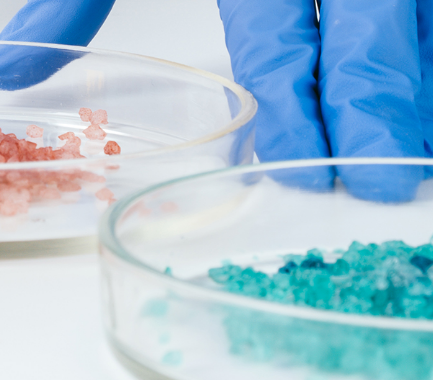Your contact
PENPET-Team - Hamburg

Tim Meister
Sales
Tel. +49 (0) 40 - 675 7 99 40
sales@penpet.de
Get in touch with us.
Urea
Urea is an organic compound from the group of carboxylic acid amides, which is used in numerous applications and syntheses in the chemical industry, and is one of the most commonly produced chemicals. In large-scale plants, the substance is produced in a two-stage process from ammonia and carbon dioxide, which first react under high pressure to form ammonium carbamate, which is then converted into urea and water. The production sites are usually located in the immediate vicinity of the ammonia production, where large amounts of carbon dioxide are already produced as a by-product, which can be used to produce urea.
The compound is an important starting material for organic synthesis and is used, among other things, to produce caffeine, hydrazine, melamine, barbituric acid and the exhaust gas treatment agent AdBlue. On the basis of the substance, urea resins are produced, which are used as impregnating agents and adhesives. Urea also serves as an effective nitrogen fertilizer for agriculture, can be used to break down harmful nitrogen oxides in the exhaust gases of vehicles and power plants, and is an important pharmaceutical ingredient. The compound is also found as a stabilizing food additive in chewing gum, and as a moisturizing ingredient in skin care products.
At PENPET, you can get urea of the highest quality, from a reliable partner who will also meet your requirements in the long term. We look forward to receiving your inquiry for an individual offer. The timely delivery of the granular solid can be done loose in the silo truck as well as in sacks and big bags with different weights.
CAS no. 57-13-6
EINECS no. 200-315-5
Molecular formula: CH4N2O
Synonyms: Urea, carbamide, carbonyldiamide, carbonic acid diamide, piagran, diaminomethanone, E 927b
Areas of application: Base material for syntheses in organic chemistry, starting material for the production of urea resins, use as nitrogen fertilizer, exhaust gas purifier, active pharmaceutical ingredient, food additive and skin care product
More Information
Urea is one of the carboxylic acid amides and is the diamide of carbonic acid. The compound's compact molecules consist of a single carbon atom, which has a double bond to an oxygen atom, and two amino groups. This structure of the substance is expressed using the alternative name diaminomethanone.
There are tight hydrogen bonds between the hydrogen atoms of the amino group and the oxygen atom, while the bonds between the nitrogen atoms and the carbon center almost have the character of a double bond. As a result, the intramolecular forces of attraction are strong, therefore the crystals only melt at high temperatures.
Urea is a colorless to yellowish-brown solid that is in crystalline form. The compound has only a very faint odor reminiscent of ammonia. The substance is very soluble in water and polar organic solvents such as glycerine, ethanol and methanol. In contrast, urea is practically insoluble in chloroform, diethyl ether and benzene.
In aqueous solution, the substance has a pH of 9. When heated, it forms ammonium salts and carbon dioxide together with acids. When heated together with bases, ammonia and carbonates are formed. Urea decomposes when it reaches its melting point at 133°C. Harmful amounts of nitrogen oxides can be released in the process.
When stored dry and airtight, urea is a chemically very stable substance, which, however, can react dangerously with a large number of compounds such as fluorine, hydrogen peroxide, alkalis, alkali chromates, alkali nitrates, alkali chlorites, perchlorates and strong oxidizing agents. There is a risk of explosion on contact with various nitrates, nitrites and certain chlorine-containing compounds. The substance should be stored in stainless steel and glass vessels.
In its pure form, urea is not flammable. However, there is a risk of a dust explosion if large numbers of fine particles of the compound are whirled up and the resulting dust-air mixture comes into contact with an ignition source. When handling open containers of the substance, it is therefore important to ensure that there is sufficient distance to open flames, sparks, electrical discharges and strongly heated surfaces.
Toxicologically, urea is largely harmless and does not represent a dangerous compound according to the GHS classification. However, when the substance is processed, contact with the skin or eyes can cause irritation and redness. Repeated exposure to the compound can lead to the development of dermatitis. Affected parts of the body should therefore be cleaned thoroughly with soap and water. The eye should be rinsed thoroughly with water after contact. An ophthalmological treatment is recommended.
Inhalation of substance dust can cause irritation of the respiratory tract. Urea is an endogenous metabolite and can be easily broken down by the body if small amounts are absorbed. However, if larger amounts of the substance are swallowed, a medical examination must be arranged.
Due to possible damage to aquatic organisms, urea is considered a slightly water-polluting substance that should not enter the ground, water bodies or waste water. In the environment, the compound contributes to the growth of toxic algae. The local authorities must be informed if large quantities of the substance escape. Urea is not subject to any special transport regulations..
